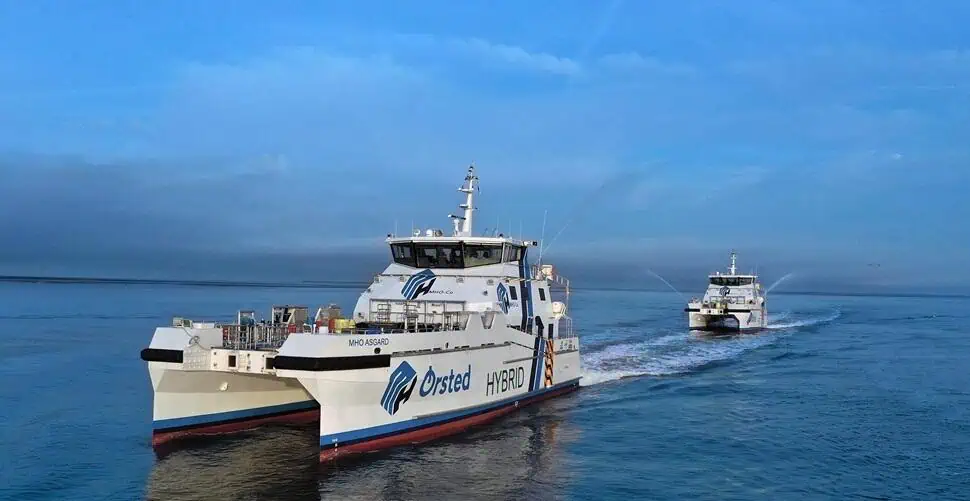Two leaders in marine electrification, Volvo Penta, and Danfoss’ Editron division, have worked together to power two of the UK’s first fully integrated hybrid electric crew transfer vessels (CTVs). The vessels have been in operation at an offshore wind farm for a month and are already making a positive environmental impact.
A recent announcement from COP26 was the promise of £160 million in new funding to support the building of floating offshore wind farms in Scotland and Wales. Although this is a significant win in the UK government’s commitment to quadruple offshore wind farm capacity to 40 gigawatts by 2030, it also means that more CTVs will be needed to deliver supplies and transport workers to the offshore sites and so reinforcing efforts such as the Global Offshore Wind Alliance and other such creditable initiatives to come out of COP26.
A recent announcement from COP26 was the promise of £160 million in new funding to support the building of floating offshore wind farms in Scotland and Wales. Although this is a significant win in the UK government’s commitment to quadruple offshore wind farm capacity to 40 gigawatts by 2030, it also means that more CTVs will be needed to deliver supplies and transport workers to the offshore sites and so reinforcing efforts such as the Global Offshore Wind Alliance and other such creditable initiatives to come out of COP26.
Wind farm transfer company MHO-Co is meeting this growing demand for transportation between shore and wind farms in the greenest and most economically viable way. The company recently took delivery of two new hybrid vessels to service its offshore customer Ørsted’s Hornsea Project 2 offshore wind farm in the North Sea. The two vessels – MHO Asgard and MHO Apollo – are powered by combined technology from Volvo Penta and Danfoss Editron.
“Cross-industry collaboration is needed now more than ever to take steps towards mitigating the negative impacts of climate change,” said Peter Granqvist, Chief Technology Officer, Volvo Penta. “By working together, we’ve been able to begin to make real change with impressive fuel and emission savings as well as more flexible operation for our customers.”
Real impacts
The two-hybrid vessels have both been in operation for just over a month and have already logged over 330 engine hours between them in the field – as well as 1000 hours on their maiden voyage from China to the North Sea. MHO Asgard and MHO Apollo have ferried over 50 workers and numerous supplies to the Hornsea Two offshore wind farm, which is located approximately 89km (55.3 miles) off the Yorkshire coast. The vessels – both equipped with Volvo Penta Inboard Performance System (IPS) – have already had an impressive environmental impact, offering fuel savings of 20.89% and reducing CO2 emissions by 20.96% compared to non-hybrid vessels, without IPS, in MHO-Co’s fleet.
Another major advantage of the hybrid vessels is the multiple power systems onboard, which Danfoss Editron and Volvo Penta have dubbed “the Power of Plenty”.
“This new system gives us more flexibility and allows us to switch between engines and do maintenance when it fits our schedule, without affecting the service to our customers,” explains Mik Henriksen, CEO of MHO-Co. “We are also able to use just one small engine when idling in the wind park offering significant fuel saving and noise advantage when in waiting position. I think we have the best system possible with the technology that exists today.”
The benefits of strong collaboration
Through their collaboration, Danfoss Editron and Volvo Penta are offering a completely unique solution to the offshore wind industry By working closely together on the design, build, and delivery of the vessels, the two companies have been able to provide a solution that allows the vessels to operate in zero-emissions electric mode for up to eight hours, or combined with fuel propulsion, to achieve a maximum speed of approximately 24 knots.
“In these hybrid crew transfer vessels, we are addressing marine electrified propulsion with one total system solution,” said Peter Granqvist.
“We’re proud to have pushed the limits of technology with Volvo Penta. MHO-Co now has access to the best technology and services from two of the leading companies that are offering marine electrification solutions to the global market,” added Kimmo Rauma, vice president, Editron division, Danfoss.












